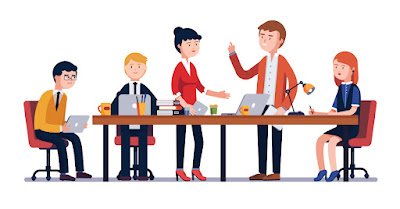Do you remember what “water cooler chat” means? That’s what we used to call the moments of unexpected collaboration at the water fountain. Office employees gained insight from one another when taking a moment to go get a drink of water. Some great ideas developed during those small, yet thoughtful moments of socializing.
But that was when offices were divided into fixed spaces. Most likely, you had a desk that stood empty half the time and only used meeting rooms on formal occasions. Since the era of the fixed space, office layouts have changed.
Today, you might still chat around the water cooler, but the way you work has been transformed. Now, workspaces are created strategically to encourage interactions that spark inspiration. Being kept in a cramped space with a limited possibility of collaboration wasn’t doing anything for anyone. In a modern, connected workplace, you move about freely, making the most of agile desks. Meeting rooms have become multi-purpose. They act as informal meeting spaces, which are now common in offices everywhere.
Many generations are working together — Generation Z is even starting to join the party — and they each have their own needs and working preferences. As times change, “one size fits all” is no longer going to suffice. To grow a successful business, employee satisfaction is a key component. Providing employees with their own preferable workspace improves employee happiness and well-being, ultimately boosting productivity. And, a boost in productivity is going to make everyone more money. However, it’s tricky to track each employee’s personal work-life preferences.
The solution? The latest workspace management technology with room reservation software.
Many organizations, including large law firms like DLA Piper and other major companies, are using room reservation software to streamline their operations and make agile operations genuinely flexible.
Even people who work at home benefit from the software. More than 8 million people in America were already working from home by 2017, according to the US Census. But, many say they lack tools and technology to work agilely. Two-thirds say they would spend more time in their office if it had better facilities. Room reservation software can make that happen for you.
What benefits does your organization gain from using room reservation software?
1. Empowered employees
- It allows employees to feel a sense of control with their workload.
- It creates a positive working environment that encourages talent to stay.
- A recent survey found that 1/3 of US office workers wanted to be more trusted to manage where they work.
2. Perfect meetings
- The smartest organizations are turning to state-of-the-art workspace management technology to manage their working environments and automate boring, time-consuming tasks.
- Room reservation software means your employees can spot suitable workspace and book it easily online via an app. They can book resources like AV, video conferencing and even catering at the same time.
- Meetings are easy to organize across multiple locations. The technology takes time zones into consideration and automatically informs everyone if any of the meeting details have changed.
- It’s a great way to remove tiresome admin tasks from your employees’ work day. That gives them more time to focus on their real work.
- Additionally, the software lowers the risk of no-shows, a common problem that makes meetings fail and costs dearly in time and frustration. The result? Perfect meetings, every time.
3. Improved Collaboration
- We know the benefits of collaboration tools like video conferencing and AV. They get teams together, no matter how far apart the co-workers are physically. This eliminates the strain and cost of travel.
- Companies love these tools and spend a lot on them, but employees can be reluctant to engage if they are hard to organize. Room reservation software removes the obstacles faced by employee uptake by making it simple to book rooms with the right equipment for an unlimited number of locations.
- So, you never turn up to your video conference only to find that the equipment is not in place — your organizer has booked it with a single click at the same time as reserving the room.
4. Better space utilization
- Keeping tabs on a changing work environment causes real headaches for office or facilities managers.
- Tracking how office space is utilized can be tough, particularly if your organization is based in many locations or if you need to recharge other departments within your company.
- Room reservation software such as Rendezvous by NFS integrates with occupancy sensors that monitor space and desk utilization in real-time and provides comprehensive reports.
- It gives you accurate data at your fingertips so you can make informed decisions about space going forward and make sure your real estate spend is justified.

What about ROI?
When the right technology is in place so that all of these factors can act together, the connected workplace gives your employees an elevated sense of control over their work environment. Satisfied employees will work harder for your business, which benefits everyone in the long run. Why miss out on the chance to eliminate stress and increase profitability? You don’t have to re-invent the wheel… There’s software for that!
If you are in management, the captured data gives a complete, real-time view of whether your space is being maximized, and how it can be improved. You are able to configure your space to meet the changing requirements of your workforce, no matter how they evolve. By making it easy for your people to find the room they need, you can also reduce the cost incurred when they decide it’s simpler to book external space. All of this amounts to the fact that room reservation software offers a quick ROI.
When competitiveness and productivity are at a premium, and talented staff is hard to find and even harder to retain, all of this should sound like good news for your business.
Allow this technology to benefit you. Get into the connected workplace.






